15 years one-stop China custom CNC machining parts factory
 155 |
Published by VMT at Jul 16 2025 | Reading Time:About 9 minutes
155 |
Published by VMT at Jul 16 2025 | Reading Time:About 9 minutes
Choosing the right steel for your CNC machining project or knife blade can be overwhelming, especially when options like 3Cr13 steel and 1095 high carbon steel seem similar at first glance. Many manufacturers and engineers struggle to determine which material offers the best balance of hardness, corrosion resistance, and machinability. The wrong choice could lead to premature wear, rust, or increased production costs. But don’t worry—this guide is here to help. By breaking down the properties, applications, and costs of both 3Cr13 steel and 1095 high carbon steel, this article gives you the clarity you need to make an informed decision that fits your exact needs.
3Cr13 steel is a corrosion-resistant stainless steel ideal for general-purpose and low-cost applications, while 1095 high carbon steel offers superior hardness and edge retention for high-impact and cutting tools. The main difference lies in their composition, with 3Cr13 containing chromium for rust resistance, and 1095 prioritizing carbon content for strength.
To help you choose between 3Cr13 steel and 1095 high carbon steel for your CNC machining parts or knife manufacturing projects, this article will compare them across several key categories—including chemical makeup, mechanical and physical properties, advantages, disadvantages, and real-world applications. Let’s dive deeper to understand which one suits your requirements better.
Key Points
3Cr13 steel is a martensitic stainless steel that belongs to the 400 series and is often used in applications where moderate corrosion resistance and good mechanical properties are required. It typically contains around 13% chromium and 0.3% carbon. This composition allows it to be hardened through heat treatment while maintaining a degree of corrosion resistance, making it suitable for budget-friendly knives, medical tools, and CNC machining parts.
The balance of chromium and carbon enables 3Cr13 to achieve decent hardness (up to HRC 56) while resisting rust in mild to moderate environments. This makes it a popular choice in CNC machining factories, especially for parts used in the food, medical, and consumer goods industries. Because it's relatively easy to machine and polish, it is widely favored in CNC machining services for low- to medium-stress applications.
Despite not being as hard or edge-retentive as higher-end steels, 3Cr13 remains a practical material where cost-efficiency, corrosion protection, and reliable performance are required.
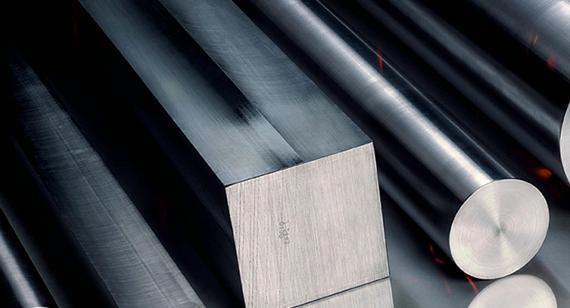
1095 high carbon steel is a plain carbon steel that contains approximately 0.95% carbon and very little chromium (often less than 0.4%). Known for its excellent hardness and edge retention, it is a top choice for heavy-duty tools, knives, and blades where cutting ability and wear resistance are priorities.
Because it lacks significant chromium, 1095 is not stainless and can rust quickly if not properly maintained. However, it makes up for this weakness with superior hardness, especially after proper heat treatment, achieving hardness values over HRC 60. In CNC machining services, 1095 is often used in parts that need exceptional edge sharpness or tensile strength.
This steel is more challenging to machine due to its hardness and lower ductility, requiring experienced handling in CNC machining factories. Nevertheless, when sharpened and cared for correctly, 1095 high carbon steel delivers outstanding performance in aggressive environments.
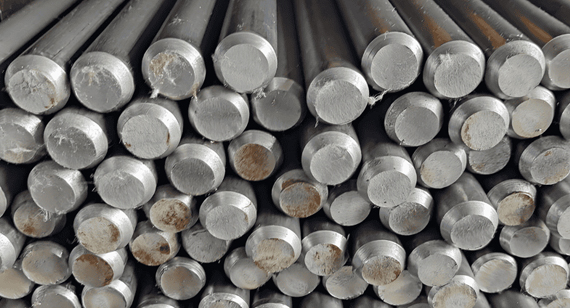
Despite their differences in composition and performance, 3Cr13 steel and 1095 high carbon steel do share a few similarities. Both are hardenable steels capable of delivering respectable performance in cutting and machining tasks. Their ability to undergo heat treatment allows them to achieve a wide range of mechanical properties depending on the application's needs.
Additionally, both materials are commonly used in knife making, although for different purposes—3Cr13 for budget or stainless applications, and 1095 for high-performance cutting. In the CNC machining industry, they are each selected for projects requiring strength and durability, even if the end-use environments differ.
Another similarity lies in their popularity. Both steels are widely available, affordable compared to exotic alloys, and supported by extensive material data, making them accessible options for CNC machining services looking to balance performance with production costs.
While both 3Cr13 steel and 1095 high carbon steel are popular in industrial and cutting tool applications, their core differences stem from their composition and how that affects performance. These steels differ significantly in corrosion resistance, hardness, edge retention, and machinability. Understanding these differences is essential when selecting materials for CNC machining parts, especially when the application environment varies in humidity, wear stress, or temperature extremes.
The most notable difference lies in chromium and carbon content. 3Cr13 is a stainless steel containing enough chromium to resist rust in wet or corrosive settings, making it ideal for CNC machining services in the food, medical, and marine industries. On the other hand, 1095 is a high carbon steel with minimal chromium, favoring hardness and edge retention over corrosion resistance, making it more suited for high-impact blades, hand tools, and specialized components where oxidation is manageable.
Let’s start by breaking down the chemical composition—the foundation for all material behavior differences.
3Cr13 Steel and 1095 High Carbon Steel: Chemical Composition
The chemical makeup of a steel alloy determines its fundamental characteristics—such as strength, corrosion resistance, heat treatment response, and machinability. CNC machining factories rely on this information to determine whether a material can handle milling, turning, or drilling without cracking, warping, or excessive wear.
3Cr13 steel is engineered as a martensitic stainless steel, with a moderate carbon content and significant chromium content, giving it a unique balance between hardness and rust resistance. This makes it highly machinable and suitable for mid-performance CNC machining parts.
1095 high carbon steel, in contrast, is a traditional plain carbon steel. It contains nearly 1% carbon, which makes it extremely hard when heat-treated but offers little resistance to corrosion. This results in a steel that excels in edge sharpness and retention but demands frequent maintenance and precise CNC processing.
Let’s examine the chemical elements in detail.
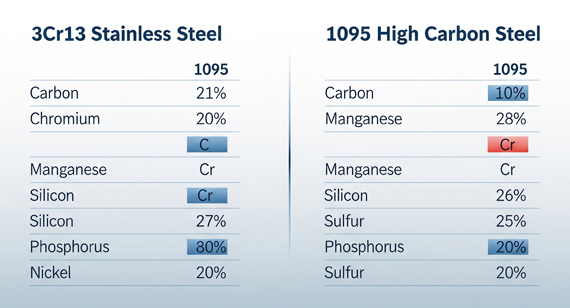
Carbon (C), %
Explanation:
Carbon significantly impacts hardness, strength, and wear resistance. 1095 steel has a much higher carbon content than 3Cr13, which allows it to achieve superior edge retention and hardness. However, this also makes it more brittle and more prone to corrosion. In contrast, the lower carbon content in 3Cr13 helps improve toughness and machinability, making it ideal for CNC machining parts that don’t require ultra-high hardness.
Chromium (Cr), %
Explanation:
Chromium is the defining element in stainless steels. 3Cr13 steel contains enough chromium to form a passive oxide layer, providing good corrosion resistance. This makes it ideal for CNC machining services where exposure to moisture or mild chemicals is expected. In contrast, 1095 steel lacks sufficient chromium to resist oxidation, requiring protective coatings or regular maintenance in humid environments.
Iron (Fe), %
Explanation:
Iron forms the base of both steels. It’s the primary element in virtually all ferrous alloys. In both 3Cr13 and 1095, iron acts as the matrix in which other elements are embedded, and its percentage is adjusted based on the total of alloying elements added.
Manganese (Mn), %
Explanation:
Manganese contributes to tensile strength and hardenability. It also helps deoxidize the steel during production. 3Cr13 contains slightly more manganese to help improve wear resistance and ductility, which benefits CNC machining. 1095 uses less manganese, focusing instead on maximizing carbon for extreme hardness.
Molybdenum (Mo), %
Explanation:
Molybdenum enhances corrosion resistance and high-temperature strength. While not a major element in either steel, trace amounts in 3Cr13 contribute marginally to rust resistance and hardness. 1095 generally doesn’t include molybdenum, as it is optimized for carbon performance.
Nickel (Ni), %
Explanation:
Nickel adds toughness and corrosion resistance, especially in stainless steels. 3Cr13 may contain small amounts of nickel, improving ductility and corrosion resistance slightly. 1095 does not include nickel, focusing instead on maximizing carbon content.
Nitrogen (N), %
Explanation:
Nitrogen, when present, can improve pitting resistance and strength in stainless steels. Trace amounts may appear in 3Cr13 due to processing. It’s typically absent in 1095.
Phosphorus (P), %
Explanation:
Phosphorus increases strength and machinability but can make steel more brittle. Both steels limit phosphorus content to prevent cracking and brittleness during CNC machining.
Silicon (Si), %
Explanation:
Silicon improves strength and acts as a deoxidizer. 3Cr13 typically has a higher silicon range, enhancing toughness and oxidation resistance. In 1095, silicon is kept moderate to maintain machinability.
Sulfur (S), %
Explanation:
Sulfur can enhance machinability but often at the cost of ductility and toughness. Both steels maintain low sulfur levels to preserve integrity, though 1095 may tolerate slightly higher levels to improve tool performance during manufacturing.
Here's a clear, professional comparison table of the chemical composition of 3Cr13 steel and 1095 high carbon steel, formatted for easy inclusion in your article or website:
Chemical Composition Comparison: 3Cr13 Steel vs. 1095 High Carbon Steel
| Element |
3Cr13 Steel (%) |
1095 High Carbon Steel (%) |
Remarks |
| Carbon (C) |
~0.30 | ~0.95 | Higher carbon in 1095 gives superior hardness and edge retention. |
| Chromium (Cr) |
12.0 – 14.0 | ≤0.40 | Chromium makes 3Cr13 corrosion-resistant; 1095 is not stainless. |
| Iron (Fe) |
Balance | Balance | Base element in both steels. |
| Manganese (Mn) |
~0.60 | ~0.30 – 0.50 | Adds strength and hardenability. Slightly higher in 3Cr13. |
| Molybdenum (Mo) |
0 – 0.30 | 0 | Present only in trace amounts in 3Cr13 for added corrosion resistance. |
| Nickel (Ni) |
≤0.60 | 0 | Small amount in 3Cr13 improves toughness and corrosion resistance. |
| Nitrogen (N) |
Trace | Not present | Improves strength and pitting resistance in 3Cr13. |
| Phosphorus (P) |
≤0.04 | ≤0.04 | Excess can cause brittleness; kept low in both. |
| Silicon (Si) |
~0.20 – 1.00 | ~0.15 – 0.30 | Improves oxidation resistance and strength. |
| Sulfur (S) |
≤0.03 | ≤0.05 | Improves machinability but may reduce toughness. |
This table helps CNC machining factories and engineers visually assess which steel better fits specific project needs—whether corrosion resistance, edge durability, or processing convenience is the priority.
When selecting a material for CNC machining parts or knives, general performance characteristics like corrosion resistance, wear resistance, machinability, and toughness play a vital role. Both 3Cr13 steel and 1095 high carbon steel are widely used, but their behavior under real-world conditions differs significantly. This section explores how each material performs across key property categories, helping engineers, manufacturers, and CNC machining factories make the best material selection for their specific applications.
Let’s examine and compare their general characteristics in detail.
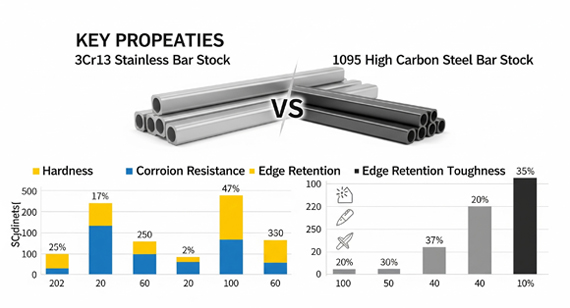
Corrosion Resistance
Wear Resistance
Hardness
Edge Retention
Machinability
Impact Toughness (J)
Sharpening
Brittleness
Toughness
Rust Resistance
General Properties Comparison Table
| Property |
3Cr13 Steel |
1095 High Carbon Steel |
Comparison Summary |
| Corrosion Resistance |
Excellent (stainless) | Poor (rust-prone) | 3Cr13 is better for moist environments |
| Wear Resistance |
Moderate | Excellent | 1095 is superior for abrasion resistance |
| Hardness |
HRC 54–56 | HRC 60–64 | 1095 is much harder |
| Edge Retention |
Moderate | Excellent | 1095 holds a sharper edge longer |
| Machinability |
Good | Low | 3Cr13 is easier to machine in CNC processes |
| Impact Toughness (J) |
Good | Low to Moderate | 3Cr13 handles shock better |
| Sharpening |
Easy | Difficult | 3Cr13 is easier to maintain |
| Brittleness |
Low | High | 3Cr13 is less prone to chipping or cracking |
| Toughness |
High | Low to Moderate | 3Cr13 is more resilient |
| Rust Resistance |
High | Very Low | 3Cr13 is more corrosion-resistant |
Mechanical properties define how a material behaves under load—whether it stretches, compresses, breaks, or springs back. These are critical for choosing the right steel in CNC machining parts, especially in industries where performance under force, heat, or impact is non-negotiable.
While 3Cr13 steel offers balanced strength and good ductility, 1095 high carbon steel provides superior hardness and tensile strength but at the cost of flexibility and corrosion resistance. In CNC machining factories, understanding these metrics is vital to avoid cracking during processing or failure during use.
Let’s examine the mechanical differences in hardness, tensile strength, ductility, and heat treatment response between the two steels.
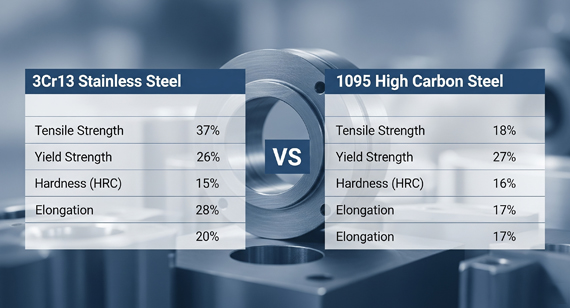
Hardness (HRC)
Explanation:
1095 can reach a significantly higher Rockwell hardness, making it suitable for tools and blades requiring extreme edge retention. 3Cr13, while not as hard, offers a safer balance for parts that require both wear resistance and toughness.
Hardness: HV (Vickers)
Explanation:
The Vickers Hardness scale, often used in CNC machining quality testing, shows that 1095 is noticeably harder. However, harder materials are also more brittle and challenging to machine without cracking.
Hardness: HRC/HRB
Explanation:
The HRB (Rockwell B) scale confirms the hardness trend. While both steels can reach high values, 1095 typically outperforms in raw cutting power—making it better suited for knife blades and chisels.
Tensile Strength (MPa)
Explanation:
1095 steel offers greater tensile strength, allowing it to withstand more stress before breaking. This makes it ideal for aggressive cutting or load-bearing parts in manufacturing and combat knives.
Yield Strength (MPa)
Explanation:
Yield strength indicates the point at which steel deforms permanently. 1095 is stronger, but more brittle. 3Cr13 may deform under lower stress but won’t crack as easily—an advantage in CNC-machined components that need minor flexibility.
Elongation %
Explanation:
3Cr13 offers better elongation, indicating superior ductility. It can bend or stretch without breaking—helpful for machined parts that experience vibration or movement.
Area Reduction %
Explanation:
A higher reduction of area means a material can be deformed significantly before breaking. 3Cr13's higher reduction value confirms its better ductility and toughness, making it more CNC-friendly.
Impact Energy Akv (J)
Explanation:
In impact testing, 3Cr13 performs better, absorbing more energy before fracture. This gives it an edge in dynamic environments, such as moving mechanical parts or repeated stress exposure.
Hardness (Quenching and Tempering)
Explanation:
Both materials respond well to quenching and tempering, but 1095 reaches a higher final hardness, making it excellent for cutting and high-wear environments.
Hardness (Annealing)
Explanation:
Annealed versions of both steels are soft and machinable. This state is ideal for pre-machining in CNC services before final heat treatment.
Ductility (%)
Explanation:
Ductility measures how much a material can stretch without breaking. 3Cr13 is far more ductile, making it a better candidate for complex CNC milling and forming.
Reduction of Area (Z/%)
Explanation:
This property supports the toughness narrative: 3Cr13 is more forgiving during stress and bending, while 1095 is more likely to fracture if overloaded.
Heating Temperature (Heat Treatment Range)
Explanation:
3Cr13 requires higher austenitizing temperatures due to its stainless composition. 1095 responds to lower heat and reaches higher hardness more easily. Understanding these ranges helps CNC machining factories manage distortion and heat control during processing.
Mechanical Properties Comparison Table
| Property |
3Cr13 Steel |
1095 High Carbon Steel |
Remarks |
| Hardness (HRC) |
50–56 | 58–64 | 1095 is harder, better for edge retention |
| Hardness (HV) |
220–260 | 290–330 | 1095 is significantly harder |
| Tensile Strength (MPa) |
750–850 | 850–980 | 1095 performs better in tensile loading |
| Yield Strength (MPa) |
450–500 | 640–760 | Higher in 1095 but more brittle |
| Elongation (%) |
15–20 | 7–10 | 3Cr13 is more ductile |
| Area Reduction (%) |
45–55 | 30–35 | 3Cr13 handles deformation better |
| Impact Energy (Akv J) |
25–35 | 10–20 | 3Cr13 has superior impact resistance |
| Quenching Hardness (HRC) |
50–56 | 58–64 | Both hardenable, 1095 reaches higher HRC |
| Annealed Hardness (HRC) |
20–25 | 20–30 | Both are soft and machinable in annealed state |
| Ductility (%) |
High (15–20%) | Low (7–10%) | 3Cr13 is better for flexible parts |
| Reduction of Area (Z/%) |
~50% | ~30% | 3Cr13 can absorb more deformation |
| Heating Temperature (°C) |
1000–1050 (quench), 200–300 (temper) | 760–820 (quench), 150–250 (temper) | 1095 requires lower austenitizing temperatures |
Physical properties determine how a material behaves under environmental conditions such as heat, electrical current, and dimensional changes. For CNC machining factories and product designers, these characteristics are critical in ensuring performance in thermally sensitive or electrically conductive environments. Whether you're developing precision CNC machining parts or heat-exposed components, understanding physical behaviors like density, thermal conductivity, or expansion rates can help you avoid failure due to warping, expansion, or overheating.
Both 3Cr13 steel and 1095 high carbon steel have distinct physical properties, shaped by their composition. 3Cr13, being a stainless steel, offers better thermal resistance and corrosion performance, while 1095, with higher carbon content, has higher thermal conductivity and density but less corrosion protection.
Let’s compare their key physical parameters.
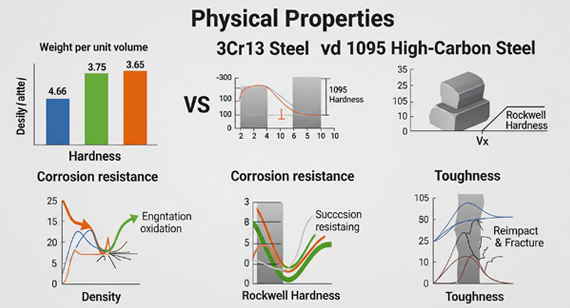
Density (g/cm³)
Explanation:
1095 is slightly denser than 3Cr13, due to its higher carbon and iron concentration. This small difference is rarely a concern but can be relevant in weight-sensitive applications like aerospace components or portable cutting tools.
Melting Point (°C)
Explanation:
Both steels have high melting points, suitable for high-temperature machining or forging. However, the chromium content in 3Cr13 contributes to a narrower and slightly lower melting range, making it slightly more stable in environments requiring thermal precision during CNC processing.
Specific Heat (J/kg·K)
Explanation:
Specific heat determines how much heat the material can absorb before rising in temperature. 3Cr13 has a slightly higher value, meaning it heats up a bit slower than 1095, which is beneficial for heat-dissipating parts or repeated heating cycles in CNC machining services.
Thermal Conductivity (W/m·K)
Explanation:
1095 has significantly higher thermal conductivity. This makes it more efficient in conducting heat—ideal for cutting tools or friction-prone surfaces. However, higher conductivity also means heat is transferred quickly, which could lead to thermal expansion issues if not controlled.
Thermal Expansion (10⁻⁶/K)
Explanation:
Lower thermal expansion in 3Cr13 means it changes shape less when heated. For precision CNC machining parts used in fluctuating temperature environments, 3Cr13 provides better dimensional stability.
Linear Thermal Expansion Coefficient (10⁻⁶/K)
Explanation:
This coefficient reinforces the earlier point: 3Cr13 is more stable dimensionally under heat. It’s a key advantage in CNC machining services where tight tolerances are required, especially in aerospace or medical applications.
Resistivity (μΩ·m)
Explanation:
1095 is more electrically conductive, which is beneficial in components where electrical discharge or resistance is relevant. 3Cr13, being a stainless steel, has higher resistivity and is better used in insulating or corrosion-prone applications.
Longitudinal Modulus of Elasticity (kN/mm²)
Explanation:
Modulus of elasticity measures stiffness—how much a material resists deformation under stress. Both steels are quite stiff, but 3Cr13 slightly outperforms 1095 in rigidity, which is valuable for high-precision CNC machining parts that must maintain form under pressure.
Magnetic Properties
Explanation:
Both steels are ferromagnetic and can be attracted to magnets. This is important for applications involving sensors, motors, or components that interact with magnetic fields.
Physical Properties Comparison Table
| Property |
3Cr13 Steel |
1095 High Carbon Steel |
Remarks |
| Density (g/cm³) |
7.70–7.75 | 7.85–7.88 | 1095 is slightly heavier |
| Melting Point (°C) |
1450–1510 | 1425–1540 | Similar, both suitable for high-temp applications |
| Specific Heat (J/kg·K) |
460–480 | 450–470 | 3Cr13 absorbs heat slightly more slowly |
| Thermal Conductivity (W/m·K) |
24–27 | 50–55 | 1095 is better at heat transfer, but may expand more |
| Thermal Expansion (10⁻⁶/K) |
10.2–11.0 | 11.0–12.0 | 3Cr13 expands less with heat |
| Linear Thermal Expansion Coefficient |
~10.4 | ~11.6 | 3Cr13 offers better dimensional stability |
| Resistivity (μΩ·m) |
0.60–0.75 | 0.15–0.30 | 1095 is more conductive |
| Elastic Modulus (kN/mm²) |
200–215 | 190–210 | 3Cr13 is slightly stiffer |
| Magnetic Properties |
Magnetic | Magnetic | Both are ferromagnetic |
This comprehensive comparison enables engineers, material buyers, and CNC machining services to match the right steel to environmental and performance demands.
Heat treatment plays a crucial role in defining the final mechanical properties of steel, including its hardness, toughness, and workability. For CNC machining parts, proper heat treatment ensures components perform reliably under stress, wear, or thermal cycling. 3Cr13 steel and 1095 high carbon steel respond differently to heat due to their distinct compositions—particularly their carbon and chromium contents.
Understanding their heat treatment characteristics helps CNC machining factories tailor the steel’s performance for specific applications such as cutting tools, wear-resistant parts, or structural components.
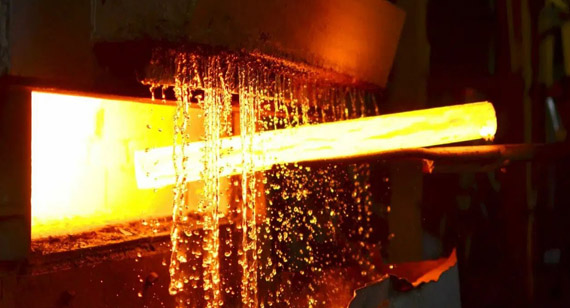
Heat Treatment of 3Cr13 Steel
3Cr13 is a martensitic stainless steel, meaning it can be hardened by heat treatment but also retains some corrosion resistance. The typical process involves annealing, quenching, and tempering.
Notes for CNC machining:
Heat-treated 3Cr13 steel can reach HRC 50–56, offering a good balance of hardness and machinability. This makes it ideal for stainless CNC machining parts such as medical tools, valve components, and kitchen blades that require moderate strength and rust resistance.
Heat Treatment of 1095 High Carbon Steel
1095 is a plain high-carbon steel known for its extreme hardness potential. It responds very well to traditional heat treatment and can be tuned for optimal cutting performance.
Notes for CNC machining:
After quenching and tempering, 1095 can reach up to HRC 60–64, making it ideal for high-performance cutting tools and knife blades. However, the high hardness makes it more challenging to machine—requiring slower feeds, specialized tools, and post-treatment grinding or finishing.
Comparison Summary: Heat Treatment Characteristics
| Heat Treatment Aspect |
3Cr13 Steel |
1095 High Carbon Steel |
Remarks |
| Annealing Temperature (°C) |
750–800 | ~800 | Both steels are annealed to improve machinability |
| Hardening Temperature (°C) |
1000–1050 | 760–820 | 3Cr13 requires a higher hardening temperature |
| Quenching Medium |
Oil or air | Water or oil | 1095 often uses water for deeper hardness |
| Tempering Range (°C) |
200–300 | 150–250 | 1095 tempered at lower temps for max hardness |
| Post-treatment Hardness (HRC) |
50–56 | 58–64 | 1095 is significantly harder when fully treated |
| Machinability After Treatment |
Moderate | Difficult | 3Cr13 is easier to machine post-hardening |
| Toughness After Tempering |
Higher than 1095 | Lower than 3Cr13 | 3Cr13 retains more impact resistance after treatment |
| Rust Resistance Post-Treatment |
Good (stainless) | Low (requires coating or oiling) | 3Cr13 offers built-in corrosion protection after processing |
Key Takeaways for CNC Machining Services
Choosing the right steel for CNC machining parts requires a balance between performance, processability, and cost. While 3Cr13 and 1095 high carbon steel both serve in tools and component manufacturing, each material comes with unique strengths and trade-offs. This section breaks down the pros and cons of each steel type, helping CNC machining factories, designers, and engineers make informed decisions based on actual application needs.
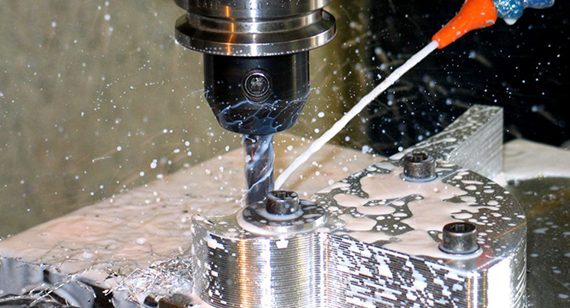
Advantages and Disadvantages of 3Cr13 Steel
3Cr13 is a martensitic stainless steel known for its corrosion resistance, balanced mechanical properties, and good machinability. Its composition includes 12–14% chromium, giving it an edge in environments where moisture or oxidation is a concern. It’s commonly used in food-grade tools, low-cost knives, and general-purpose CNC machining parts.
Advantages of 3Cr13 Steel
One of the key benefits of 3Cr13 steel is its cost-effectiveness. It offers good mechanical and corrosion resistance at a fraction of the price of premium stainless or tool steels. This makes it ideal for large-scale production or consumer-grade CNC components.
With a hardness range of HRC 50–56 after heat treatment and decent ductility, 3Cr13 strikes a useful balance between hardness and toughness. It’s hard enough to retain a cutting edge but tough enough to resist chipping and breakage under mechanical stress.
3Cr13 steel is easy to machine, polish, and weld, making it highly compatible with CNC machining services. It can be annealed, quenched, and tempered with standard industrial equipment. Its moderate hardness allows for smoother cutting, lower tool wear, and faster throughput.
This steel type can be hardened and tempered to specific application needs. Heat treatment significantly improves its performance, enhancing its resistance to wear and deformation. The process is also less sensitive compared to high-carbon steels, reducing risks during production.
Thanks to its corrosion resistance and adequate durability, 3Cr13 is well-suited for everyday applications such as kitchen knives, scissors, surgical instruments, and general-purpose components in humid environments.
Disadvantages of 3Cr13 Steel
Compared to harder steels like 1095, 3Cr13 has lower edge retention. This means tools and knives made from 3Cr13 steel will dull faster and require more frequent sharpening to maintain cutting performance.
Although classified as stainless, 3Cr13 has lower chromium content than high-end stainless steels like 316 or 440C. In aggressive chemical or saltwater environments, it can corrode over time without protective coatings or routine maintenance.
While it performs adequately for light to moderate-duty applications, 3Cr13 lacks the tensile and yield strength of higher carbon or alloy steels. It’s not ideal for applications that involve high impact, pressure, or prolonged wear.
In demanding industrial environments with abrasive wear, 3Cr13 tends to degrade more quickly than high carbon or tool steels. It is better suited for consumer-grade or low-friction uses.
Like many martensitic stainless steels, 3Cr13 experiences a significant drop in hardness at elevated temperatures, limiting its use in high-heat or friction-intensive components without secondary surface treatments.
Advantages and Disadvantages of 1095 High Carbon Steel
1095 high carbon steel is a traditional tool steel known for exceptional hardness and edge retention. Containing ~0.95% carbon, it delivers outstanding cutting performance and wear resistance when properly heat-treated. However, these advantages come with trade-offs, particularly in corrosion resistance and brittleness.
Advantages of 1095 High Carbon Steel
1095 steel can reach up to HRC 60–64 after heat treatment, making it one of the hardest conventional steels used in knives and industrial tools. Its edge stays sharp for extended periods, even under repetitive cutting or scraping conditions.
The high carbon content and fine grain structure give 1095 superior resistance to abrasion and surface wear, making it ideal for high-friction parts like chisels, bushcraft knives, and dies. In dry environments, its durability outperforms many stainless alternatives.
1095 responds well to basic heat treatment, requiring no complex alloy stabilization. Its austenitizing and tempering stages are straightforward, making it accessible to smaller machining shops or knife makers who don’t have advanced heat-treating equipment.
While more expensive than 3Cr13, 1095 is relatively inexpensive compared to D2, M390, or S90V. It delivers high-end performance at mid-range pricing, especially for users who prioritize cutting power over corrosion resistance.
1095 has been used for over a century in tools, knives, and industrial parts. Its performance is well-documented and trusted, making it a safe choice for projects that demand high hardness and minimal blade deformation.
Disadvantages of 1095 High Carbon Steel
Perhaps the biggest downside of 1095 is its complete lack of corrosion resistance. Without coatings, oiling, or bluing, it will rust rapidly—especially in humid, marine, or food-processing environments. This limits its use to dry conditions or coated applications.
In the hardened state, 1095 is challenging to cut or shape, requiring specialized CNC tooling and slower machining speeds. Excessive tool wear, burr formation, and cracking are common risks during machining unless handled properly.
At maximum hardness, 1095 becomes brittle and susceptible to chipping or fracturing. This makes it unsuitable for dynamic load environments unless it's tempered back for toughness, which then compromises edge retention.
Although the process is simple, achieving optimal hardness and toughness requires careful temperature control during quenching and tempering. Poorly managed heat treatment can result in uneven hardness, cracks, or weak grain boundaries.
Even with coatings, 1095 tools and parts require frequent oiling and storage care. Without proper maintenance, corrosion will degrade performance, appearance, and safety over time—especially in high-humidity regions.
Here's a clear and concise comparison table summarizing the advantages and disadvantages of 3Cr13 Steel and 1095 High Carbon Steel:
| Aspect |
3Cr13 Steel |
1095 High Carbon Steel |
| Advantages | - Affordable price compared to high-end steels | - Exceptional hardness and edge retention (HRC 60–64) |
| - Balanced hardness and toughness | - Excellent wear resistance | |
| - Easy to process and manufacture | - Simple heat treatment process | |
| - Responds well to heat treatment | - Affordable among high-performance steels | |
| - Suitable for daily use in moderately corrosive environments | - Widely available and proven | |
| Disadvantages | - Requires more frequent sharpening | - Poor corrosion resistance |
| - Limited resistance in highly corrosive environments | - Difficult to machine when hardened | |
| - Lower strength compared to higher-end steels | - High brittleness when hardened | |
| - Wears faster under high wear conditions | - Requires skilled heat treatment for optimal results | |
| - Loses hardness at high temperatures | - Requires frequent maintenance and care |
This table provides a quick overview to help in selecting the appropriate steel for CNC machining parts and other applications.
Selecting the appropriate steel type is crucial for ensuring the performance, durability, and safety of CNC machining parts across various industries. Both 3Cr13 steel and 1095 high carbon steel find distinct applications due to their unique mechanical and chemical properties. While 3Cr13 offers corrosion resistance and balanced toughness, 1095 excels in hardness and edge retention. Below are typical applications and part examples illustrating where each steel type is best utilized.
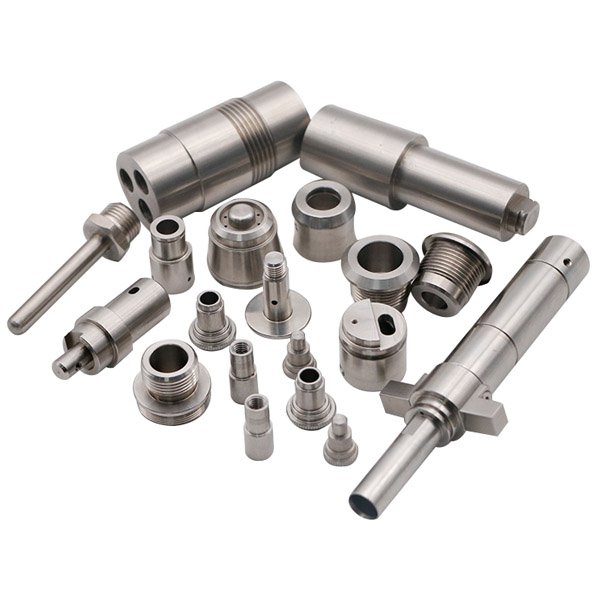
Kitchen Knives
Outdoor Knives
Surgical Instruments
Marine Applications
Chemical Processing
Building and Construction
Both steels see use in the building and construction industry, but for different reasons:
Food and Beverage Industry
Both steels can be found in the automotive industry:
Here's a clear comparison table outlining the applications and part examples for 3Cr13 Steel and 1095 High Carbon Steel:
| Application Area |
3Cr13 Steel |
1095 High Carbon Steel |
| Kitchen Knives |
Good corrosion resistance, moderate hardness, affordable for home use | Superior sharpness and edge retention, requires more maintenance |
| Outdoor Knives |
Suitable for humid climates, corrosion resistant but less hard | Preferred for toughness and edge retention, needs oiling to prevent rust |
| Surgical Instruments |
Used for non-critical instruments requiring corrosion resistance | Generally avoided due to poor corrosion resistance |
| Marine |
Suitable for marine hardware and fittings due to stainless properties | Limited use; requires protective coatings to prevent rust |
| Chemical Processing |
Suitable for mild corrosive environments | Rarely used unless coated due to vulnerability to corrosion |
| Building and Construction |
Used for corrosion-resistant fasteners and tools | Used for cutting tools and wear-resistant parts |
| Food and Beverage Industry |
Ideal for food processing equipment needing hygiene and rust resistance | Generally avoided unless in dry applications or coated |
| Medical Devices |
Suitable for less critical components with corrosion resistance | Not recommended for corrosion-prone or sterilization-required parts |
| Automotive |
Used in stainless fasteners, brackets, and parts requiring corrosion resistance | Used in wear parts, springs, and cutting tools needing high strength |
This table offers a straightforward overview of where each steel type excels or falls short across different industries.
Cost is a decisive factor in choosing between 3Cr13 steel and 1095 high carbon steel, especially for CNC machining factories and manufacturers balancing budget constraints with performance needs. While both steels offer economic advantages compared to premium alloys, their price differences and long-term cost implications can influence project success. This section compares initial material costs and considers the total cost of ownership to provide a comprehensive cost-benefit analysis.
Initial Cost Comparison
3Cr13 steel is generally more affordable upfront than 1095 high carbon steel, particularly when considering the additional expenses involved in protective treatments or coatings for 1095 to prevent corrosion. The stainless nature of 3Cr13 reduces the need for expensive surface finishing or corrosion inhibitors, making it a cost-effective choice for applications exposed to moisture or mild corrosive environments.
In contrast, 1095 high carbon steel, while competitively priced among tool steels, often requires additional processing steps such as coating, oiling, or specialized storage to protect against rust. These added requirements can increase the effective initial cost, especially for manufacturers unfamiliar with handling non-stainless steels.
Long-term Cost Benefits
When evaluating long-term costs, 3Cr13 steel’s corrosion resistance reduces maintenance and replacement expenses, making it a practical choice for parts exposed to humidity, chemicals, or wear. Its easier machinability also translates to lower tooling wear and shorter CNC machining cycles, further reducing operational costs.
Conversely, 1095 steel’s superior hardness and wear resistance can result in longer-lasting cutting edges and wear parts, lowering replacement frequency in high-friction applications. However, the higher risk of corrosion means that if not properly maintained, parts may fail prematurely, increasing total lifecycle costs.
Summary
| Cost Aspect |
3Cr13 Steel |
1095 High Carbon Steel |
| Initial Material Cost |
Lower, due to stainless properties and less processing needed | Moderate, but often higher due to protective coatings and handling |
| Processing Cost |
Lower machinability costs and standard heat treatment | Higher tooling and machining costs due to hardness |
| Maintenance Cost |
Lower due to corrosion resistance | Higher maintenance and care to prevent rust |
| Replacement Frequency |
Moderate, balanced wear and corrosion | Lower in wear resistance but risk of corrosion-related replacement |
This cost comparison helps CNC machining service providers and manufacturers optimize material selection based on both upfront budgets and long-term value.
Choosing between 3Cr13 steel and 1095 high carbon steel depends on the specific requirements of the application, including factors such as corrosion resistance, hardness, machinability, cost, and environmental conditions. Both steels have strengths and limitations that make them suitable for different use cases. Understanding these distinctions allows CNC machining factories and manufacturers to select the most effective material for producing reliable and cost-efficient CNC machining parts.
When Should 3Cr13 Steel Be Used?
3Cr13 steel is an excellent choice when corrosion resistance is a key concern. Its stainless nature makes it well-suited for components exposed to moisture, mild chemicals, or outdoor environments where rust prevention is critical. Additionally, 3Cr13 is ideal when:
When Should 1095 High Carbon Steel Be Used?
1095 high carbon steel is preferable when maximum hardness, edge retention, and wear resistance are paramount, especially in environments where corrosion is less of a concern or can be controlled through coatings and maintenance. It is the material of choice when:
Summary Table: Choosing Between 3Cr13 and 1095 Steel
| Criteria |
3Cr13 Steel |
1095 High Carbon Steel |
| Corrosion Resistance |
High; suitable for moist and corrosive environments | Low; needs coatings or maintenance |
| Hardness and Edge Retention |
Moderate; good for everyday use | Very high; excellent for cutting and wear |
| Machinability |
Easy to machine and process | Harder to machine, requires specialized tools |
| Cost |
Lower initial and processing cost | Moderate initial cost but higher processing cost |
| Maintenance |
Low maintenance due to stainless properties | Requires regular maintenance to prevent rust |
| Typical Applications |
Kitchen knives, marine parts, medical devices | High-performance knives, tools, wear parts |
Choosing the right steel ultimately depends on balancing performance requirements, environmental factors, and cost considerations. Proper selection ensures optimal part longevity, functionality, and cost efficiency for CNC machining factories and end-users alike.
Choosing the right steel is crucial for knife makers and users who seek a balance between sharpness, durability, corrosion resistance, and ease of maintenance. Both 3Cr13 steel and 1095 high carbon steel are popular choices for knives but offer distinct advantages and trade-offs. Understanding how each performs in knife applications helps manufacturers and consumers select the best material to meet their needs.
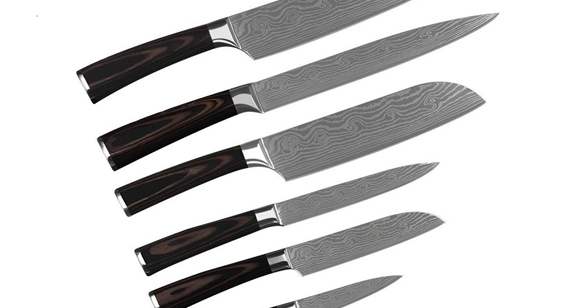
Is 3Cr13 Steel Good for Knives?
3Cr13 steel is considered a good material for knives used in everyday or moderate conditions, particularly where corrosion resistance is important. Its stainless nature provides excellent resistance to rust and staining, making it ideal for kitchen knives, pocket knives, and outdoor knives that may frequently come into contact with moisture.
In terms of performance, 3Cr13 knives offer balanced hardness (around HRC 50–56), providing reasonable edge retention and durability without being too brittle. These knives are easy to sharpen and maintain, which makes them user-friendly for casual users or those new to knife care.
However, 3Cr13 steel does not achieve the extreme hardness or edge retention of high carbon steels like 1095. Therefore, while it performs well in corrosion-prone environments, it may require more frequent sharpening and isn’t recommended for heavy-duty or precision cutting tasks where superior edge performance is critical.
Is 1095 Steel Good for Knives?
1095 high carbon steel is widely regarded as an excellent choice for knives that prioritize sharpness, edge retention, and toughness. With a carbon content close to 1%, 1095 steel can be heat treated to very high hardness levels (HRC 60–64), allowing knives to hold a sharp edge for a long time.
This steel is favored by professional knife makers and outdoor enthusiasts who need knives that withstand heavy use, such as survival knives, hunting knives, and bushcraft tools. Its high hardness and toughness also allow for fine edge geometry and superior cutting performance.
However, 1095 steel lacks corrosion resistance and is prone to rust if not properly maintained. Knives made from 1095 require regular cleaning, oiling, and careful storage to prevent corrosion, which can be a drawback for casual users or those in humid environments.
Summary
| Criteria |
3Cr13 Steel |
1095 High Carbon Steel |
| Corrosion Resistance |
High; suitable for wet or humid use | Low; prone to rust without maintenance |
| Edge Retention |
Moderate; requires frequent sharpening | High; excellent edge retention |
| Hardness (HRC) |
50–56 | 60–64 |
| Toughness |
Good balance; less brittle | Tough but can be brittle if over-hardened |
| Maintenance |
Low; easy to care for | High; requires regular care |
| Best Use Cases |
Kitchen, everyday, and outdoor knives | High-performance, survival, hunting knives |
In conclusion, 3Cr13 steel knives are ideal for users who value corrosion resistance and ease of maintenance, while 1095 steel knives excel in sharpness and durability for demanding tasks but require more upkeep. The choice depends on the user’s environment, maintenance capability, and performance expectations.
VMT is a leading factory specializing in stainless steel CNC machining parts services, committed to delivering high-quality, precision-engineered components for a wide range of industries. Leveraging advanced CNC machining technology and a deep understanding of stainless steel materials like 3Cr13 steel, VMT ensures parts meet stringent standards for accuracy, durability, and corrosion resistance.
With extensive experience in working with various stainless steels and carbon steels, including 3Cr13 steel CNC machining parts and 1095 high carbon steel CNC machining parts, VMT offers customized manufacturing solutions tailored to client specifications. The factory’s capabilities encompass milling, turning, grinding, and surface finishing, enabling the production of complex parts used in medical devices, automotive components, marine equipment, food processing machinery, and more.
VMT prioritizes quality control, employing rigorous inspection methods and maintaining certifications that guarantee consistent product excellence. Their dedicated team of engineers works closely with customers to optimize designs for manufacturability and cost efficiency, ensuring competitive pricing without compromising performance.
For businesses seeking reliable CNC machining services and high-precision CNC machining parts, VMT stands out as a trusted partner. Their comprehensive service approach combines material expertise, advanced machinery, and responsive customer support, making them a preferred choice among CNC machining factories in the stainless steel sector.
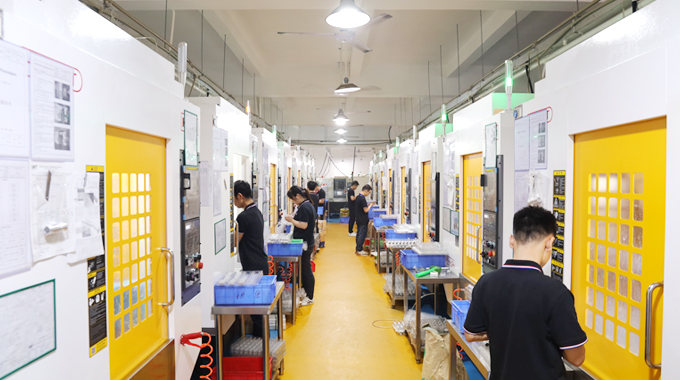
Choosing between 3Cr13 steel and 1095 high carbon steel depends largely on the specific demands of the application, environmental conditions, and cost considerations. 3Cr13 steel offers a balanced combination of corrosion resistance, moderate hardness, and excellent machinability, making it ideal for CNC machining parts used in humid, corrosive, or daily-use environments such as kitchen tools, medical instruments, and marine applications. On the other hand, 1095 high carbon steel excels in hardness, edge retention, and wear resistance, suitable for high-performance cutting tools, outdoor knives, and industrial wear parts where durability and sharpness are critical, but corrosion protection is managed separately.
Both steels have their distinct advantages and disadvantages, and understanding their chemical composition, mechanical properties, heat treatment responses, and application scope is crucial for making informed material selections. CNC machining factories and service providers can leverage this knowledge to optimize manufacturing processes, control costs, and meet client requirements more effectively.
By partnering with experienced CNC machining service providers like VMT, who specialize in stainless steel CNC machining parts and understand the nuances of materials such as 3Cr13 and 1095 steels, manufacturers can ensure high-quality, cost-efficient, and reliable components that fulfill diverse industrial needs.
What is 3Cr13 equivalent to?
3Cr13 steel is approximately equivalent to AISI 420 stainless steel. Both are martensitic stainless steels with similar chemical compositions and performance characteristics, especially in terms of corrosion resistance and moderate hardness.
What steel is similar to 1095?
Steels similar to 1095 high carbon steel include W1, W2, and 1075, which also contain high carbon levels and provide similar edge retention and hardness. O1 tool steel is also comparable in some cutting tool applications, though it has better machinability.
Is 3Cr13 a good stainless steel?
Yes, 3Cr13 is a good stainless steel for general-purpose applications. It offers a balance of corrosion resistance, affordability, and machinability, making it popular for kitchen knives, low-cost tools, and CNC machining parts that require moderate durability.
What is the HRC of 3Cr13 steel?
After heat treatment, 3Cr13 steel typically achieves a Rockwell Hardness (HRC) between 50 and 56, depending on the tempering process.
Is 3Cr13 steel easy to sharpen?
Yes. 3Cr13 steel is relatively soft and easy to sharpen, which makes it suitable for users who prefer low-maintenance blades. However, it may require more frequent resharpening due to its lower edge retention.
What is the toughest knife steel?
Among steels, CPM 3V, 5160, and S7 tool steel are considered some of the toughest due to their high impact resistance and ability to withstand abuse without chipping. Toughness depends on the balance between hardness and ductility.
Is 3Cr13 better than 440?
3Cr13 is generally less hard and less wear-resistant than 440C, but it is more affordable and easier to machine. 440C offers superior edge retention and is often preferred for premium knife blades, while 3Cr13 is ideal for budget applications.
What is the HRC of 1095 steel?
When properly heat-treated, 1095 high carbon steel can reach a Rockwell Hardness of HRC 60 to 64, which makes it ideal for applications requiring high edge retention and sharpness.
Is 3Cr13 steel good for machetes?
Yes, 3Cr13 is a reasonable choice for budget-friendly machetes that need corrosion resistance and ease of maintenance. However, for more rugged use, higher carbon steels may offer better performance and edge retention.
Which steel has the sharpest blade?
Steels that can be hardened to a high level and have fine grain structures—such as 1095, VG10, or CPM S30V—are capable of achieving extremely sharp edges. 1095 steel is often praised for its ability to take a very fine, razor-sharp edge.
Is 1095 steel sharp?
Yes. 1095 high carbon steel is known for its ability to achieve and hold a razor-sharp edge, making it a favorite for survival knives, tactical blades, and cutting tools.
Which is better, 5160 steel or 1095 steel?
5160 steel offers superior toughness and impact resistance, making it better for swords or large chopping blades. 1095 steel has higher edge retention and hardness, ideal for precision cutting tools. The choice depends on intended use.
What is 1095 steel equivalent to?
1095 is closely equivalent to UHB 20C and C100 steels, which are also high-carbon, simple steels used in blade and tool manufacturing. These steels have similar carbon content and performance characteristics.
Is D2 steel better than 1095 steel?
D2 steel offers better wear resistance and corrosion resistance than 1095, thanks to its higher chromium content and complex alloying. However, 1095 is easier to sharpen and often has better toughness. Choice depends on application needs.
What is the ASTM equivalent of 3Cr13?
The ASTM equivalent for 3Cr13 is ASTM Type 420 (UNS S42000) stainless steel. It shares similar properties, including martensitic structure and moderate corrosion resistance.
Is 3Cr13 better than 440?
For cost-sensitive or moderate-use applications, 3Cr13 may be preferable due to its affordability and ease of machining. However, 440C steel is better in terms of hardness, edge retention, and wear resistance.
What steel is CR3 steel equivalent to?
The term CR3 steel usually refers to cold-rolled mild steel used in structural or forming applications, which differs entirely from 3Cr13. It's not a blade or tool steel and isn’t directly comparable to 3Cr13 or 1095.
What is the difference between 3Cr13 and 316?
3Cr13 is a martensitic stainless steel, focused on hardness and wear resistance, while 316 is an austenitic stainless steel with superior corrosion resistance, especially in chemical and marine environments. 316 is softer and not heat-treatable.
Will 3Cr13 steel rust?
While 3Cr13 is stainless, it can still rust in highly corrosive or salty environments, especially if not properly maintained. It resists rust better than carbon steel but not as well as 316 stainless steel.
What is the difference between 3Cr13 stainless steel and D2 steel?
D2 is a tool steel with high wear and corrosion resistance and better edge retention. 3Cr13 is a softer stainless steel with better corrosion resistance in some environments but inferior hardness and wear resistance compared to D2.
What is the ASTM equivalent standard of 1018 steel?
The ASTM equivalent of 1018 steel is ASTM A108. 1018 is a low-carbon steel commonly used in structural and machining applications due to its excellent weldability and machinability.
